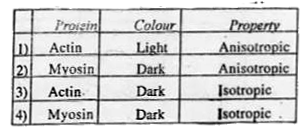Myofibrils show dark and light bands is
striped muscles
cardiac muscles
unstriped muscles
both (1) and (2)
The correct Answer is:D
To answer the question "Myofibrils show dark and light bands in which muscle?", we can follow these steps:
Step 1: Understand the Structure of Myofibrils
Myofibrils are the basic units of muscle tissue, primarily found in skeletal muscles. They are long, thread-like structures that run parallel to each other and are responsible for muscle contraction.
Hint: Myofibrils are essential components of muscle fibers.
Step 2: Identify the Composition of Myofibrils
Each myofibril is composed of two main types of protein filaments: myosin (thick filaments) and actin (thin filaments). The myofibrils contain approximately 1500 myosin filaments and 3000 actin filaments.
Hint: Remember the two types of filaments that make up myofibrils.
Step 3: Understand the Arrangement of Filaments
The myosin and actin filaments are arranged in such a way that they partially overlap. This overlapping creates alternating light and dark bands along the length of the myofibrils.
Hint: The arrangement of these filaments is crucial for the appearance of bands.
Step 4: Define the Light and Dark Bands
The light bands, known as I bands, consist only of actin filaments and are isotropic to polarized light. The dark bands, known as A bands, contain both myosin filaments and the overlapping ends of actin filaments, making them anisotropic to polarized light.
Hint: Differentiate between the I bands and A bands based on their composition.
Step 5: Identify the Types of Muscle
The presence of these dark and light bands indicates that the muscle is striated. Striated muscles include skeletal muscles (also referred to as striped muscles) and cardiac muscles, both of which exhibit these bands.
Hint: Striated muscles are characterized by their banding pattern.
Step 6: Exclude Other Muscle Types
Unstriped muscles, also known as smooth muscles, do not have the striated appearance because they lack the alternating light and dark bands.
Hint: Unstriped muscles are smooth and do not show the banding pattern.
Conclusion
Based on the information gathered, myofibrils show dark and light bands in both striped muscles (skeletal muscles) and cardiac muscles. Therefore, the correct answer is that myofibrils show dark and light bands in both striped and cardiac muscles.
Final Answer: Both 1 (striped muscles) and 2 (cardiac muscle).
Myofibrils are the basic units of muscle tissue, primarily found in skeletal muscles. They are long, thread-like structures that run parallel to each other and are responsible for muscle contraction.
Each myofibril is composed of two main types of protein filaments: myosin (thick filaments) and actin (thin filaments). The myofibrils contain approximately 1500 myosin filaments and 3000 actin filaments.
The myosin and actin filaments are arranged in such a way that they partially overlap. This overlapping creates alternating light and dark bands along the length of the myofibrils.
The light bands, known as I bands, consist only of actin filaments and are isotropic to polarized light. The dark bands, known as A bands, contain both myosin filaments and the overlapping ends of actin filaments, making them anisotropic to polarized light.
The presence of these dark and light bands indicates that the muscle is striated. Striated muscles include skeletal muscles (also referred to as striped muscles) and cardiac muscles, both of which exhibit these bands.
Unstriped muscles, also known as smooth muscles, do not have the striated appearance because they lack the alternating light and dark bands.
Based on the information gathered, myofibrils show dark and light bands in both striped muscles (skeletal muscles) and cardiac muscles. Therefore, the correct answer is that myofibrils show dark and light bands in both striped and cardiac muscles.
Topper's Solved these Questions
Similar Questions
Myofibrils are
View SolutionRead the statement regarding myofibril and choose the correct option
1. Each myofibril has alternate dark and light bands.
2. In the centre of each 'A' band is an elastic fibre called 'Z' -line 3. 'A' and 'I' bands are arranged alternately throughout the length of myofibril
4. Sarcomere is the functional unit of contraction
5. Central part of thick filament not overlapped by a thin filament is the 'M' line
View Solution
Knowledge Check
Dark bands are
AA-bandBB-bandCI-bandDZiline.
Skeletal muscle appears striated due to the presence of two characteristic proteins in alternating dark and light bands. Which of the following is a correct match of the protein with its light refractive property and colour?

View SolutionRefer to the characteristics given below and identify how many are true for a skeletal muscle ?
Uninucleated , branched , dark and light band , actin and myosin filaments , spindle - shaped cells
View SolutionPoints which are correct with respect to cardiac muscle ?
(i) Have dark and light bands
(ii) Involuntory in nature
(iii) Similar to smooth muscle in structure
(iv) Muscle fibres are branched, cylindrical
(v) get fatigued after a long period.
View SolutionThe distance or length of the myofibril between two adjacent z-bands is called
View SolutionA-band and l-band
View SolutionIn a myofibril, each I band is bisected by
View SolutionIn a myofibril , the band which contains only actin filament is also known as
View Solution
